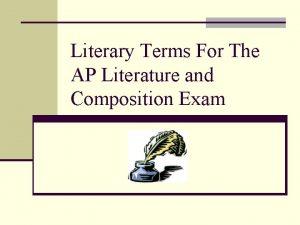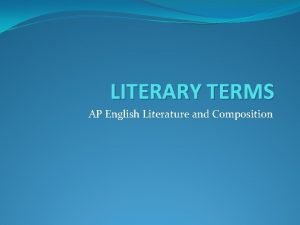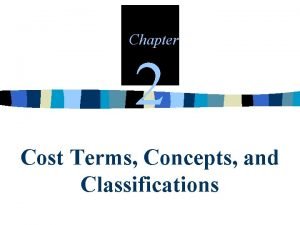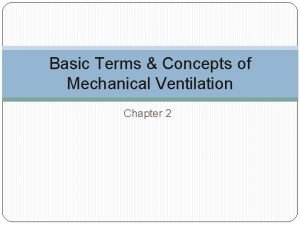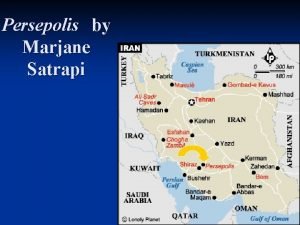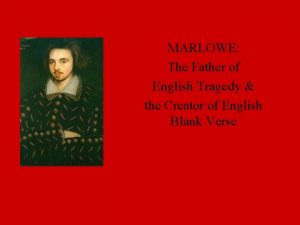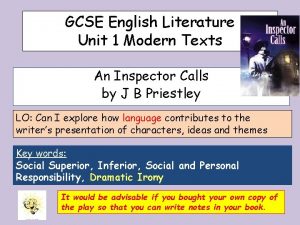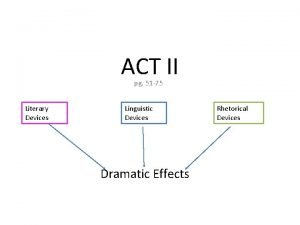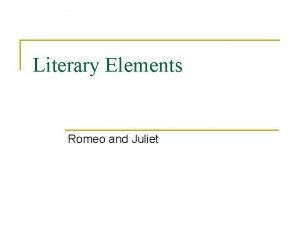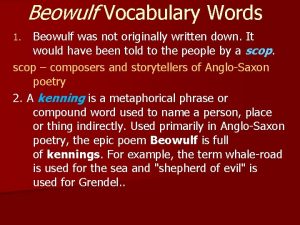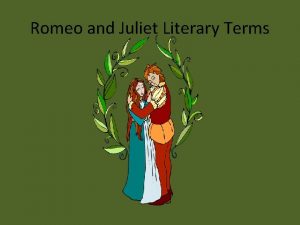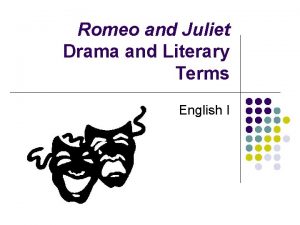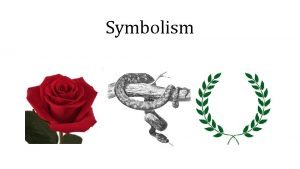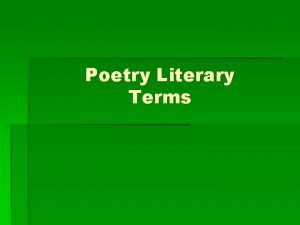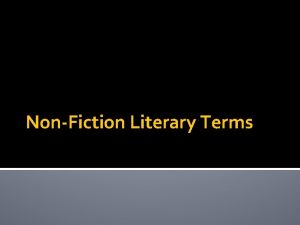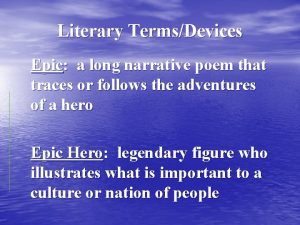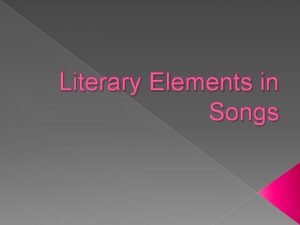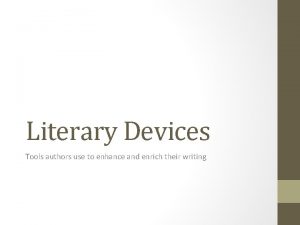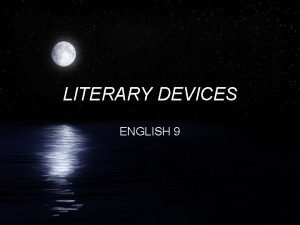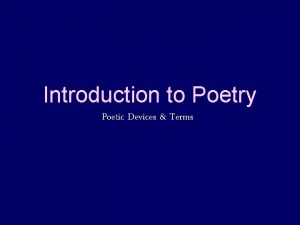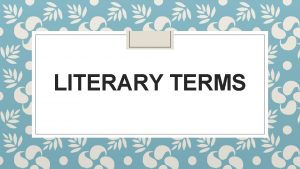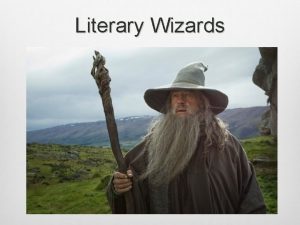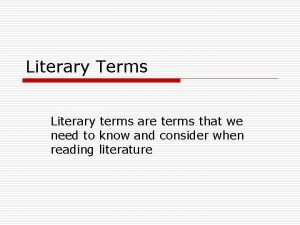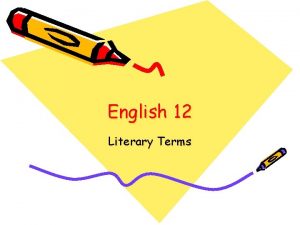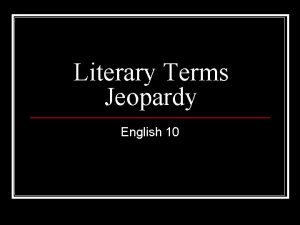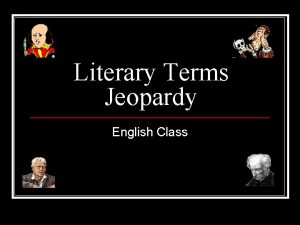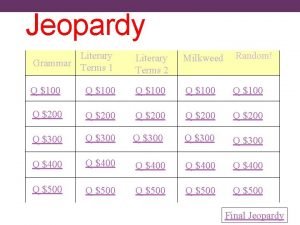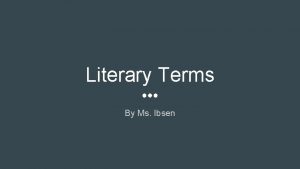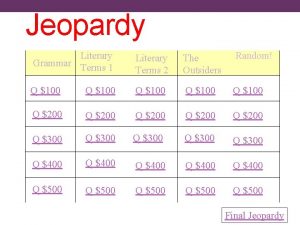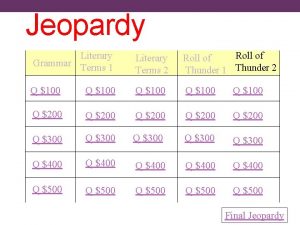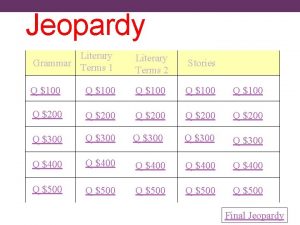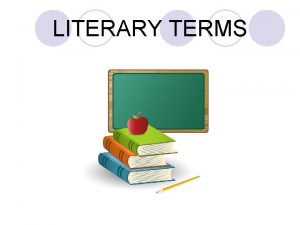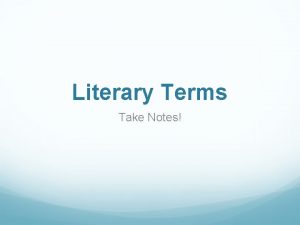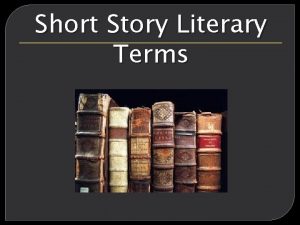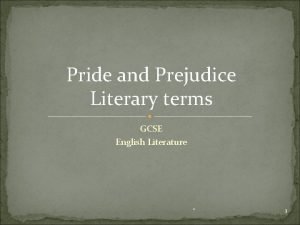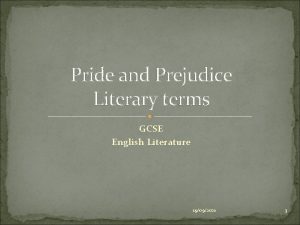English 9 Literature Unit Literary Terms and Concepts





























- Slides: 29

English 9 Literature Unit Literary Terms and Concepts

What is point of view? Simple! Point of view is: who tells the story And 2. how the story gets told. 1.

Point of View �Three questions to ask when figuring out the point of view in a story: 1. Who tells the story? 2. How much is this person allowed to know? 3. To what extent does the narrator look inside the characters and report their thoughts and feelings?

Omniscient POV �Story is told in the third person by a narrator whose knowledge is unlimited. �These types of narrators know ALL. �They can interpret behavior, and see into the minds and hearts of all characters in the story. Omniscient = “all knowing”

Third-Person Limited POV �Told in the third person from the viewpoint of one character in the story. �These point-of-view characters are the filters through whose eyes and minds writers look at the events. Therefore, we only get ONE character’s perspectives on the events in the story. Often, these perspectives give the reader clues about the character himself (or herself).

Stream of Consciousness �A subset of third-person limited POV �Presents the apparently random thoughts going through a character’s head �Memories and present experiences get mixed

First-Person POV �Author disappears into one of the characters, who tells the story in first person �In “How I Met My Husband, ” the protagonist tells the story in first person �We get direct experiences in reality; however, there can be no interpretation by the author because no one else is observing from the outside.

Objective/Dramatic POV �Narrator disappears into a kind of “roving sound camera”; can only record what is seen and heard �No commentary or interpretation of events can take place �Readers are “spectators”; therefore, they must interpret everything for themselves �Truest form of this would be a story of all dialogue; once authors add words of their own, they begin to interpret

More questions… �Is the story being interpreted by a narrator or by one of the characters? �If by one of the characters, then how does this character’s mind and personality affect the interpretation? Is the character reliable? �Can point of view shift within a story? YES!

Examples of Point of View

Omniscient Point of View As the girl walked up the hill, she realized that the atmosphere was just too quiet. The cardinal tipped his head back and drew breath to sing, but just as the first note passed his beak he heard the crack of a dead branch far below his perch high in the maple tree. Startled, he looked down, cocking his head to one side and watching with great interest while the man rattled the blades of grass as he tried to hide himself behind the tree. As the man saw her start up the hill, he moved quickly into the shelter of the huge old maple tree. If she saw him now, everything would be ruined. She thought she saw a shadow move high up on the slope, but when she looked again it was gone. The man thought if he could stay hidden until she came within range, she'd have to talk to him. Wouldn't she? The girl shuddered as she felt a silent threat pass over her. It felt like a cloud creeping over the sun.

Third Person Limited POV He gripped the dollar bill tightly. “You can’t have it, ” he told her. OR As she walked up the hill, she realized that the atmosphere was just too quiet. There was no sound from the cardinal who she so often heard singing from the top of the maple tree. She thought she saw a shadow move high up on the slope, but when she looked again it was gone. Nevertheless, she shuddered as she felt a silent threat pass over her. It felt like a cloud creeping over the sun. *The main point in Third Person Limited POV is that we can only see thoughts and perspectives of ONE character in the story. Harry Potter is this way; we can see the deeper thoughts and perspectives of only Harry (not the other secondary characters).

First Person POV I was minding my own business when Mom burst in. “What’s with you? ” I grumbled. As I walked up the hill, I realized that the atmosphere was just too quiet. There was no sound from the cardinal who was nearly always singing from the top of the maple tree. I thought I saw a shadow move high up on the slope, but when I looked again it was gone. Still, I shuddered as I felt a silent threat pass over me like a cloud over the sun.

Objective Point of View The girl walked up the quiet hillside. In the top of the maple tree, the cardinal tipped his head back and drew breath to sing. A dead branch cracked on the ground below the bird's perch. The man stepped on the branch and rattled the blades of grass as he moved behind the tree. He watched the girl come up the hillside toward him. Her gaze shifted quickly and warily from one shadowy area high on the slope to another, and she shuddered.

Second Person POV We did not discuss this particular point of view; however, it is important to be able to recognize it if you come across it (seldomly used). You walk into the cave and hear a low rumble. “What is it? ” you wonder. As you walk up the hill, you realize that the atmosphere's just too quiet. There's no sound from the cardinal you know is almost always singing from the top of the maple tree. You think you see a shadow move high up on the slope, but when you look again it's gone. You shudder as you feel a silent threat pass over you. You feel cold, like a cloud just passed over the sun. Second person POV is used seldomly because it distances the reader instead of drawing them in. Second person POV is used in “Choose Your Own Adventure” stories.

Symbol, Allegory, & Fantasy

Symbol �A literary symbol is something that means more than what it suggests on the surface. �Can be an object, a person, a situation, an action, or some other element that has a literal meaning, and yet, it also represents or suggests other meanings.

Name Symbolism �Instead of serving as simply a label, a symbolic name can be used to suggest something about the character. Example: General Zaroff His name is fitting (he was a former “officer of the Czar”, and now acts like a czar himself).

Symbolic Use of Objects and Actions �Sometimes, these symbols are difficult to detect, and sometimes, in less realistic stories, the symbol will be so obvious that it demands interpretation. �In other words, the reader must discover the meaning of the symbol in order to entirely understand the story. (Symbol carries the meaning)

Be careful… �Most stories operate on a literal level, so don’t read symbols INTO the story. �It is better to miss the symbolism in a story than to pervert the meaning of the story by making up symbols.

Allegory �A story that has a second meaning beneath the surface. �The author gives characters, objects, or events added significance. �Each literal item has a corresponding abstract idea or moral principle.

Example Many Medieval and Renaissance religious allegories were intended to illustrate the progress of a Christian individual through life. Pilgrim’s Progress by Paul Bunyan Character named “Christian” journeys toward salvation, encountering along the way temptations like despair. * ”Young Goodman Brown” is an allegorical work.

Fantasy �A nonrealistic story �Requires “a willing suspension of disbelief” In other words, the reader must be willing to accept the premise of a strange or marvelous world, in which a character falls down a rabbit hole or climbs up a beanstalk or finds himself in an alien spaceship.

Fantasy continued… �Fantasies can be purely commercial entertainment, but they can also be serious literary works. �“Truth in fiction is not to be identified with a realistic method. ”

Irony �Irony is a technique used to convey a truth about human experience by exposing some contradiction of a character’s behavior or a society’s traditions. �Irony helps to critique the world by laughing at the many varieties of human eccentricity (quirks, idiosyncrasies).

Verbal Irony �Verbal irony (can often be used to create sarcasm): A figure of speech in which the speaker says the opposite of what he or she intends to say. Example: “Hunters in the Snow” Kenny says to Tub, “You’re just wasting away before my very eyes. ” This is ironic and sarcastic because Tub is obese.

Dramatic Irony � Dramatic Irony: A contrast between what a character says or thinks and what the reader knows to be true. Example: “How I Met My Husband” Loretta Bird says about Mrs. Peebles, “She wouldn’t find time to lay down in the middle of the day, if she had seven kids like I got. ” This is ironic because Loretta Bird finds all kinds of time to sit and visit at the Peebles’ home instead of staying home with her children.

Situational Irony �Situational Irony: There is a discrepancy between appearance and reality, between expectation and what actually happens, or between what is and what would seem appropriate. Example: “The Most Dangerous Game” It is ironic that Rainsford, “the celebrated hunter, ” should become the hunted. This is a reversal of his expected role.

Irony continued… �Irony is effective because it allows the writer to be indirect in making his/her point. �Sentimentality is the opposite of irony, in that it is very direct; it is not used in fiction as genuine emotion, but rather made-up (contrived) or excessive emotion.
 Ap literature terms
Ap literature terms Ap lit literary terms
Ap lit literary terms English literary periods and their characteristics
English literary periods and their characteristics Cost classifications
Cost classifications Transpulmonary pressure formula
Transpulmonary pressure formula Graphic novel terms
Graphic novel terms Polynomial degrees and terms
Polynomial degrees and terms Identify like terms
Identify like terms Father of tragedy
Father of tragedy English literature unit 1
English literature unit 1 Hyperbole examples in romeo and juliet
Hyperbole examples in romeo and juliet 75 literary terms elements and devices
75 literary terms elements and devices Repetition in romeo and juliet
Repetition in romeo and juliet Beowulf vocabulary and literary terms
Beowulf vocabulary and literary terms Figurative language in romeo and juliet prologue
Figurative language in romeo and juliet prologue Apostrophe in poetry
Apostrophe in poetry Si unit to english unit
Si unit to english unit Jeopardy literary terms
Jeopardy literary terms Symbolism literary device
Symbolism literary device Object that represents literature
Object that represents literature Five figure of speech
Five figure of speech Nonfiction literary terms
Nonfiction literary terms A long narrative poem that traces the adventures of a hero
A long narrative poem that traces the adventures of a hero Simile music definition
Simile music definition Literary device
Literary device Symbol literary devices
Symbol literary devices Literary elements metaphor
Literary elements metaphor Mood
Mood Rondeau poem example
Rondeau poem example What is an elegy in literature
What is an elegy in literature
